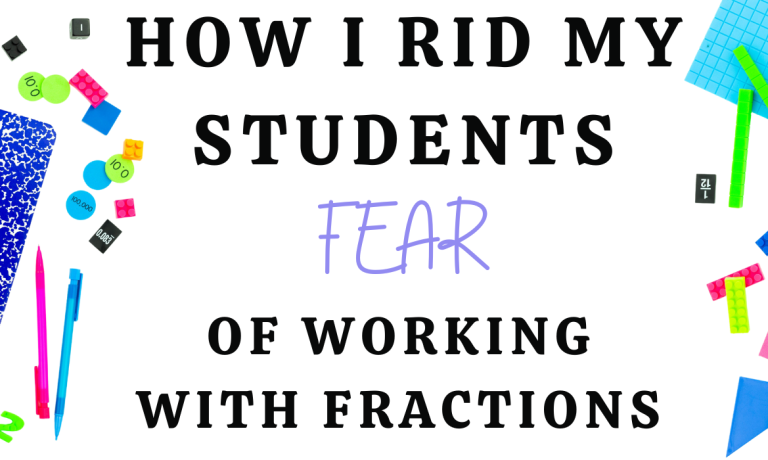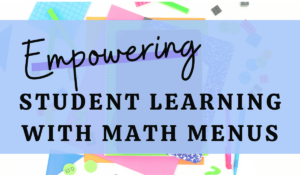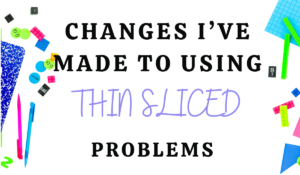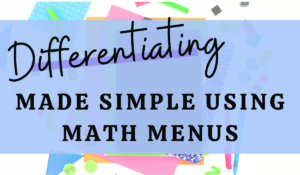Do you have students who immediately tense up when they see a fraction? You can tell that their anxiety has spiked and they are dreading this math class. I have seen this almost every year. Especially when you teach upper elementary or middle school, there have been so many opportunities for the students to have bad experiences with fractions at this point. Keep reading for the simple strategy that I have used every year to rid my students fear of working with fractions.
Drawing
Drawing has changed the way my students feel about fractions! Is drawing the most efficient way to solve all fraction problems? No. But it is a strategy that is non threatening to students. Drawings give more students access, and thus makes problems with fractions less scary. Eventually, students will see connections with algorithms and find more efficient ways to solve problems. But using drawings to start a fraction unit can rid students fear of working with fractions because it is something that is visual so they can understand what is actually happening.
Equivalent Fractions
Finding equivalent fractions is a perfect place to start with drawings. Students are able to see that they are making an equivalent fraction, meaning the fractions takes up the same amount space. Using drawings allows students to visually see this connection. Then students are able to make the connection between their visuals for equivalent fractions and seeing that they can find the equivalent fraction by multiplying the first fraction by a fraction equal to one whole to get their equivalent second fraction.
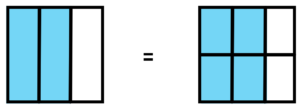
Adding and Subtracting Fractions
A very common mistake kids make when adding and subtracting fractions is just adding straight across. As a math teacher, I cringe when students hand me a paper where they did this. Before anything, I go over why this would not make sense by making connections to real life. If you want more information on this, click here to read my blog post! After that, having students create equivalent fractions using drawings gives them some flexibility as well as a less threatening way to engage with the work. And again, the drawings allows them to make the connections to the algorithms that we are all so eager to get to!
Converting Fractions Greater Than 1 to Mixed Numbers
This is another great use of drawings. Students know that one whole is a fraction where the numerator and the denominator are the same (and if they don’t know that, drawings can help!). Drawing that visually affirms that understanding. Connections are made that then two wholes would have numerator that is double the denominator. Then if there is extra, the drawing will show that. Is drawing the most efficient strategy for this? No. But it is a strategy that visually shows them, so they are gaining understanding and losing some of that fraction fear. They can also make the connection to the algorithm of multiplying the denominator by the whole number and then adding the numerator.

Dividing Whole Numbers by Fractions
There are three different types of problems when we are dividing whole numbers by fractions:
1. Whole number ÷ unit fraction
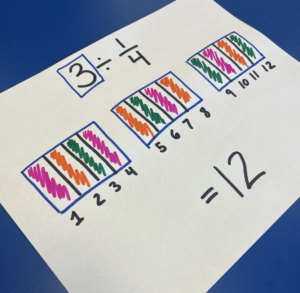
2. Whole number ÷ fraction = whole number
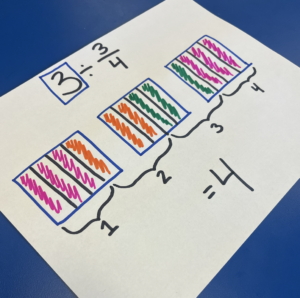
3. Whole number ÷ fraction = mixed number

Using drawings with all of these support student understanding. When students start with the drawings, their fear decreases for many reasons. One reason is that it is easier for them to understand where they made a mistake, and go back and fix it, because the process is natural and makes sense, as opposed to just multiplying by the reciprocal, an algorithm that is nonsense in their mind. However, using drawings also helps them make the connection to multiplying by the reciprocal. Often times, as students are drawing these types of problems (especially problem type 1) they are able to see the connection between the drawing and multiplying by the reciprocal.
Dividing Whole Numbers by Whole Numbers
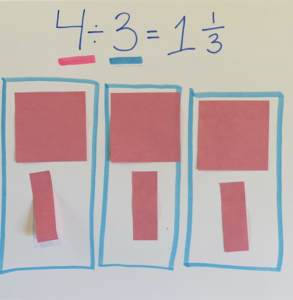
Often times when students are taught 4 ÷ 3 they are told to just make the first number the numerator and the second number the denominator, giving them 4/3. But why does that work? Drawing this out, or even using a manipulative like a post it note, shows the students what is happening. It shows what they are splitting up, how many groups they are making, and if there is something left over, what they do with it. Want to see a video of this in action? Here is a video on my instagram of me using post it notes to support understanding!
Use Context
Finally, along with using drawings, models, and hands on manipulatives to support students with fractions, another great strategy is providing context. Instead of just giving students number, give them a word problem. Too often, curriculums put word problems towards the end of the unit. But starting with the word problems helps students understand what is ging on because there is context for them. Here is a video example that explains even more details about the importance of providing context, especially when fractions are involved.
As I hope you can see, there are so many benefits to using drawings to rid students fear of working with fractions. Drawings are very engaging. They are accessible for more students. They support conenctions between algorithms, and often support students coming up with those algorithms on their own! Fractions can be very overwhelming for students, especially in the upper elementary grades. This tip of how I rid my students fear of working with fractions is something that I have used for years, and fractions have always quickly become one of their favorite activities.
Want an awesome and free activity to get students thinking deeply about fractions? Click here to download my “Always, Sometimes, Never” fractions activity!

